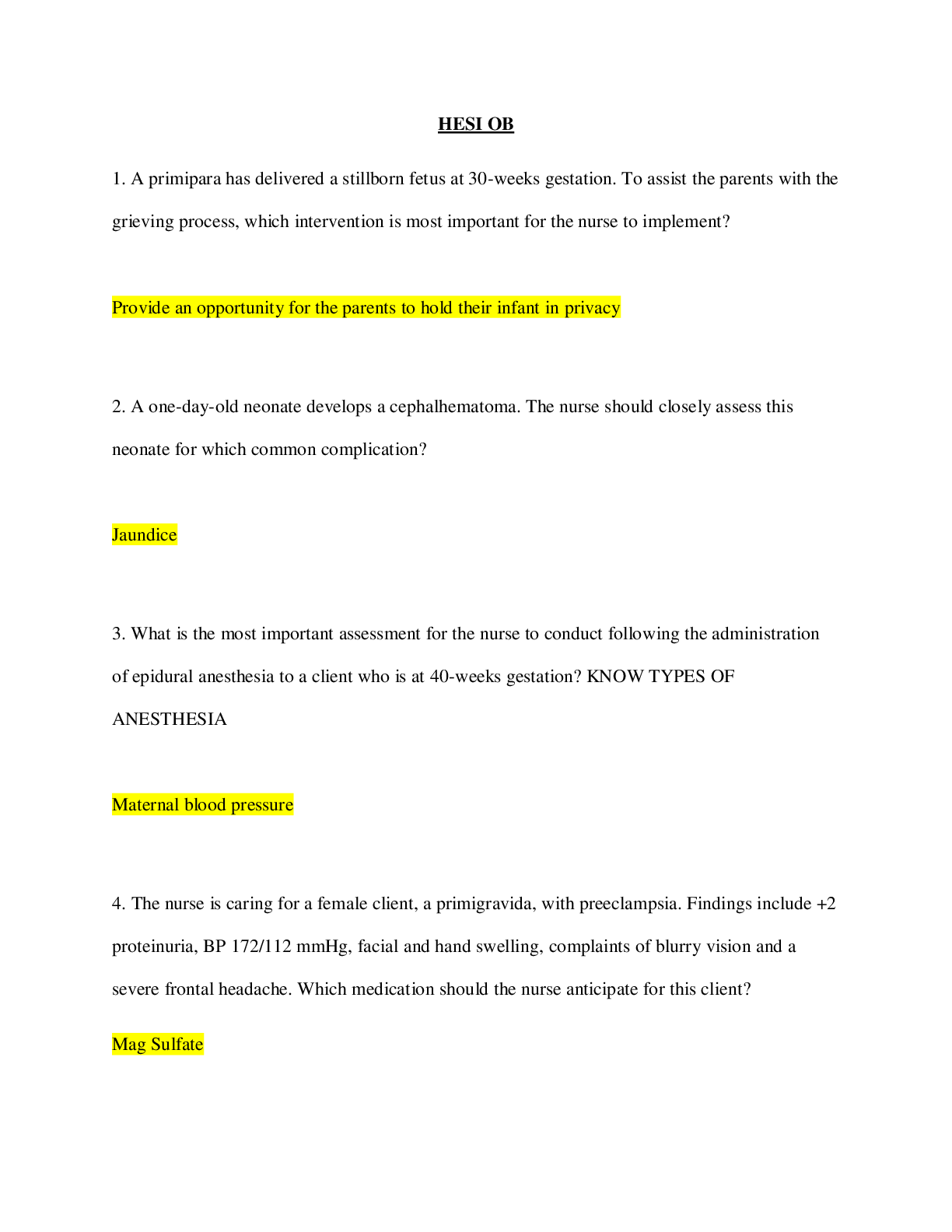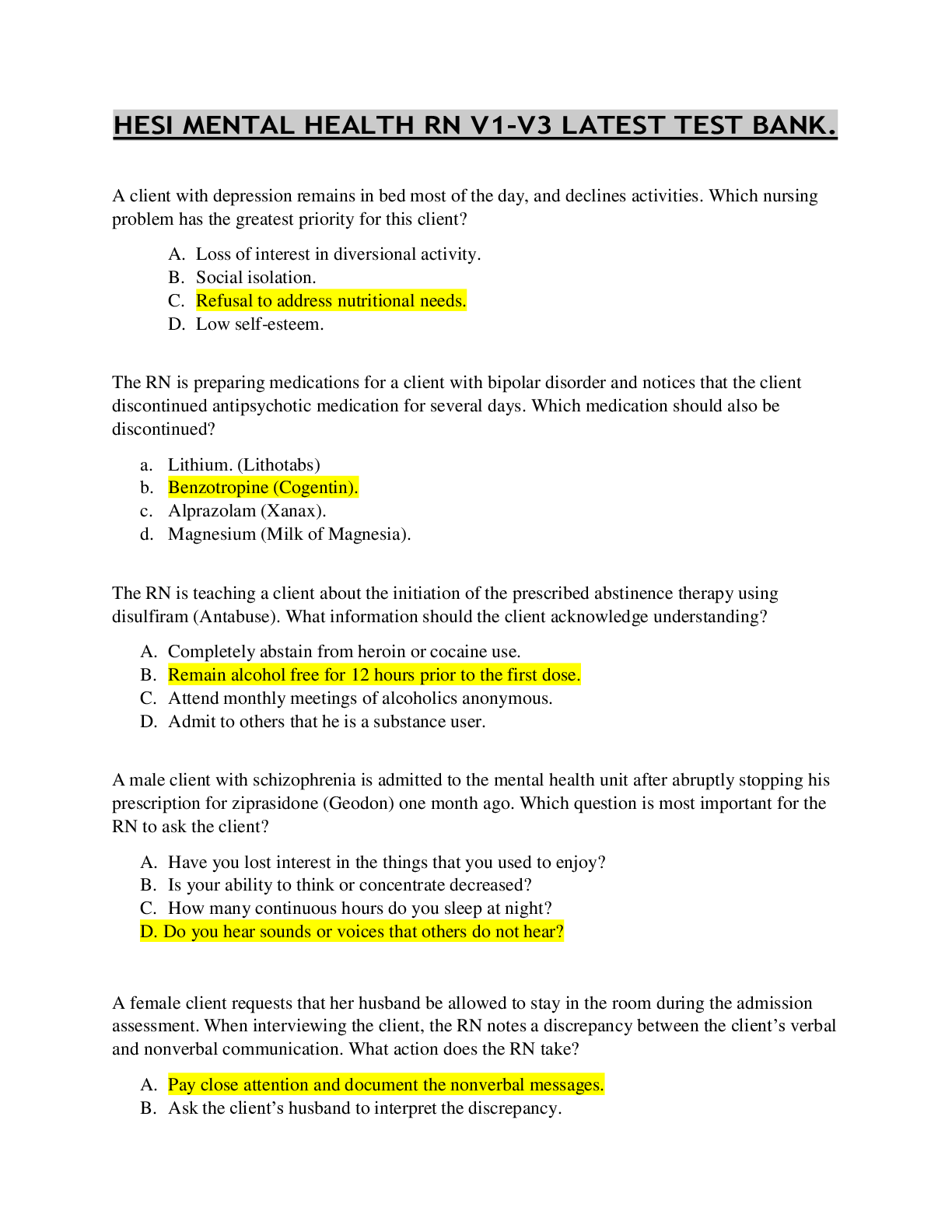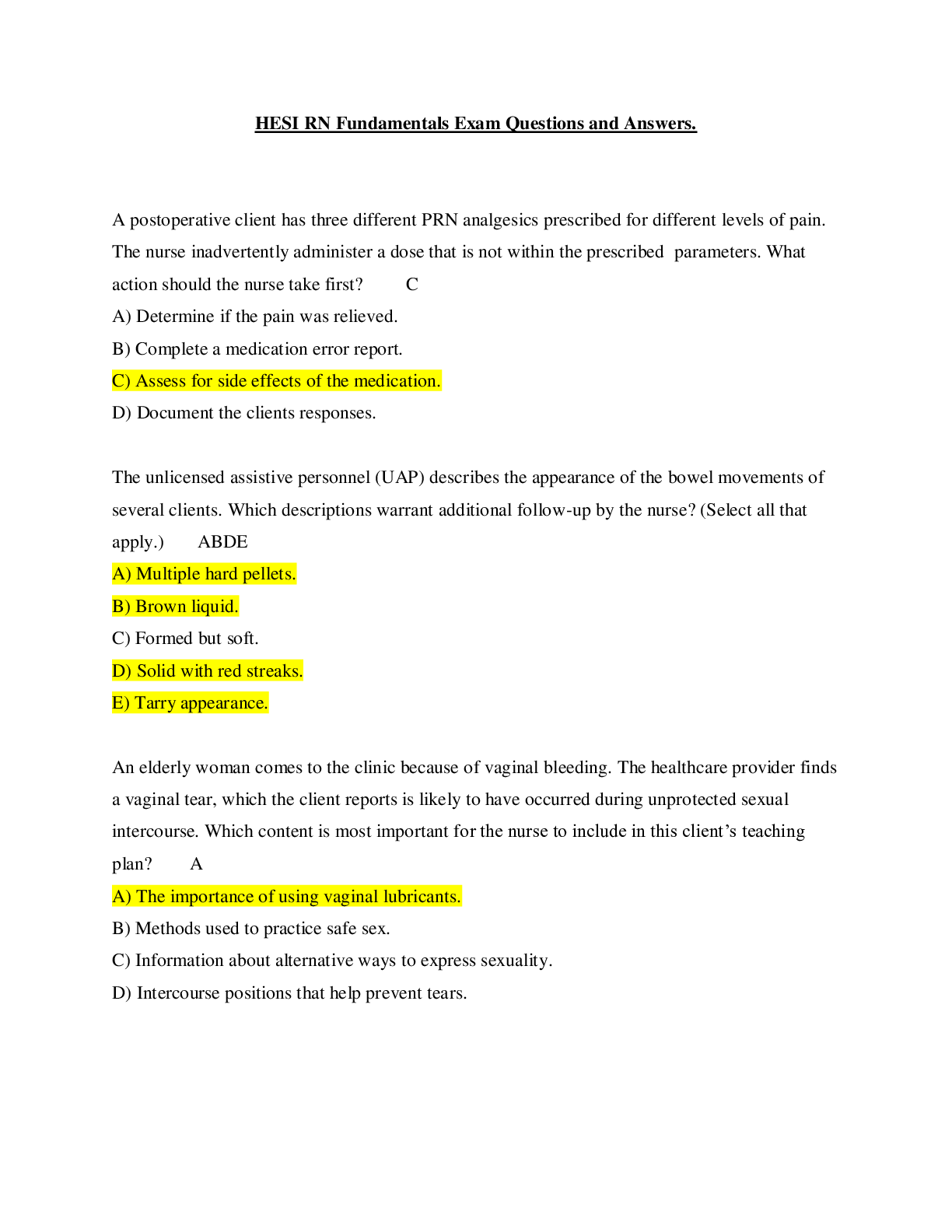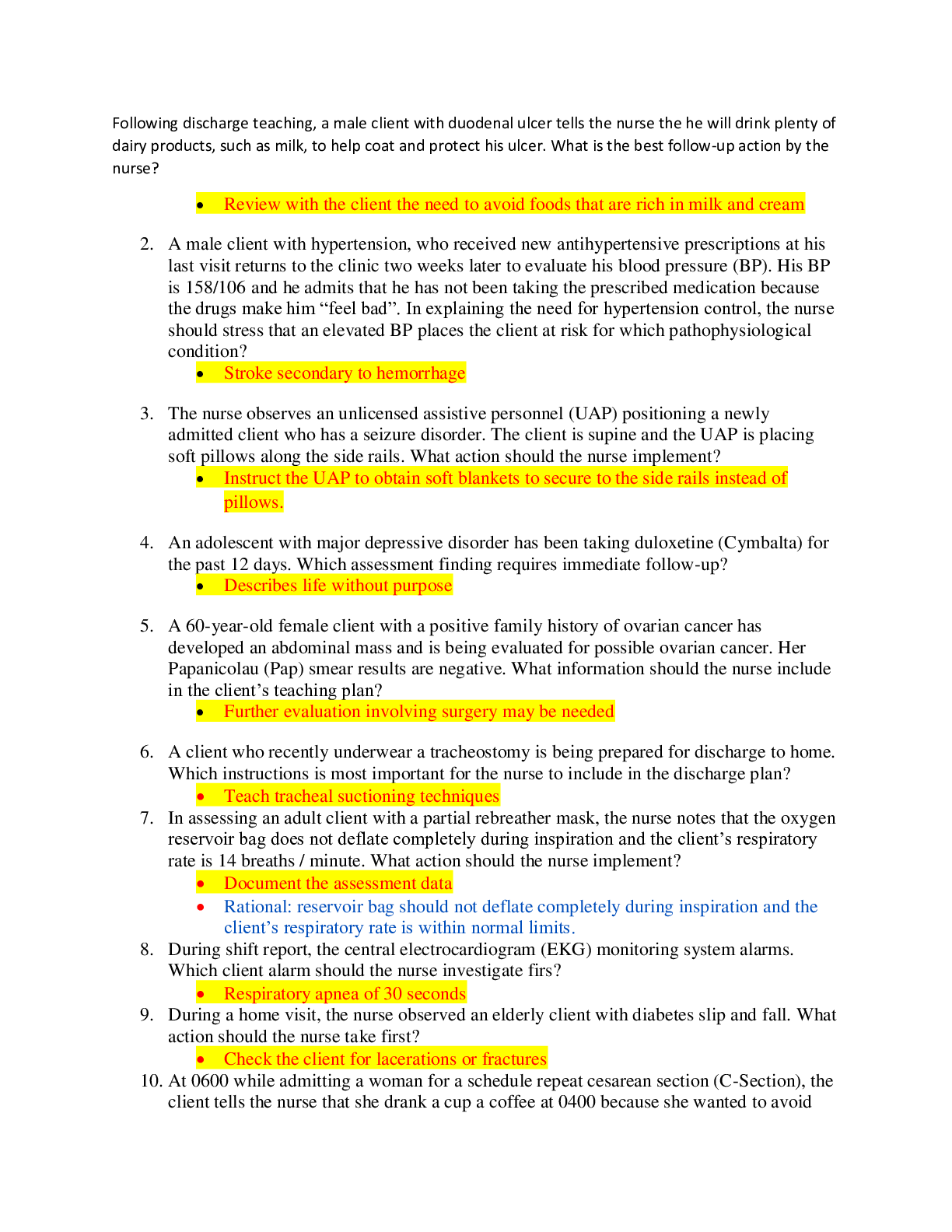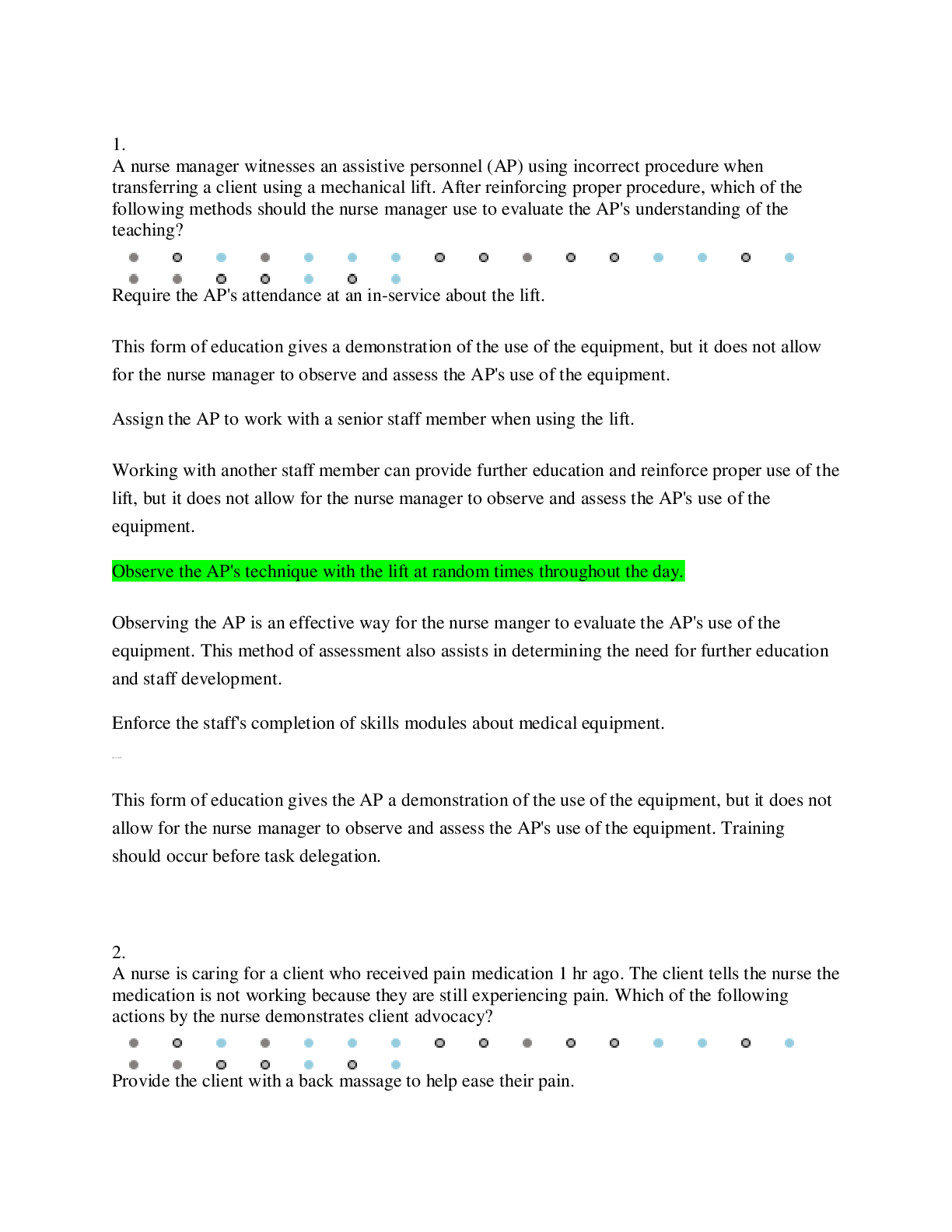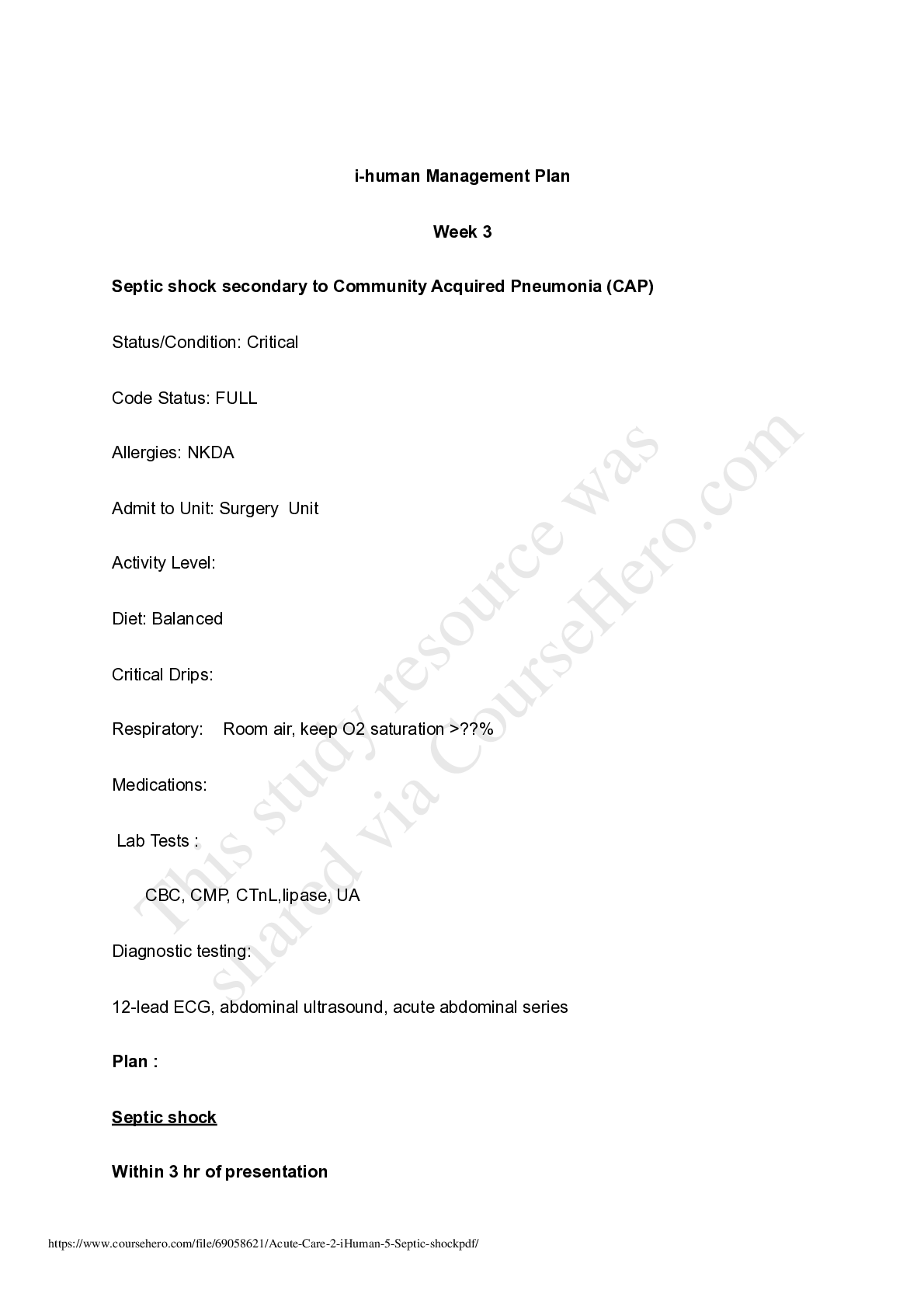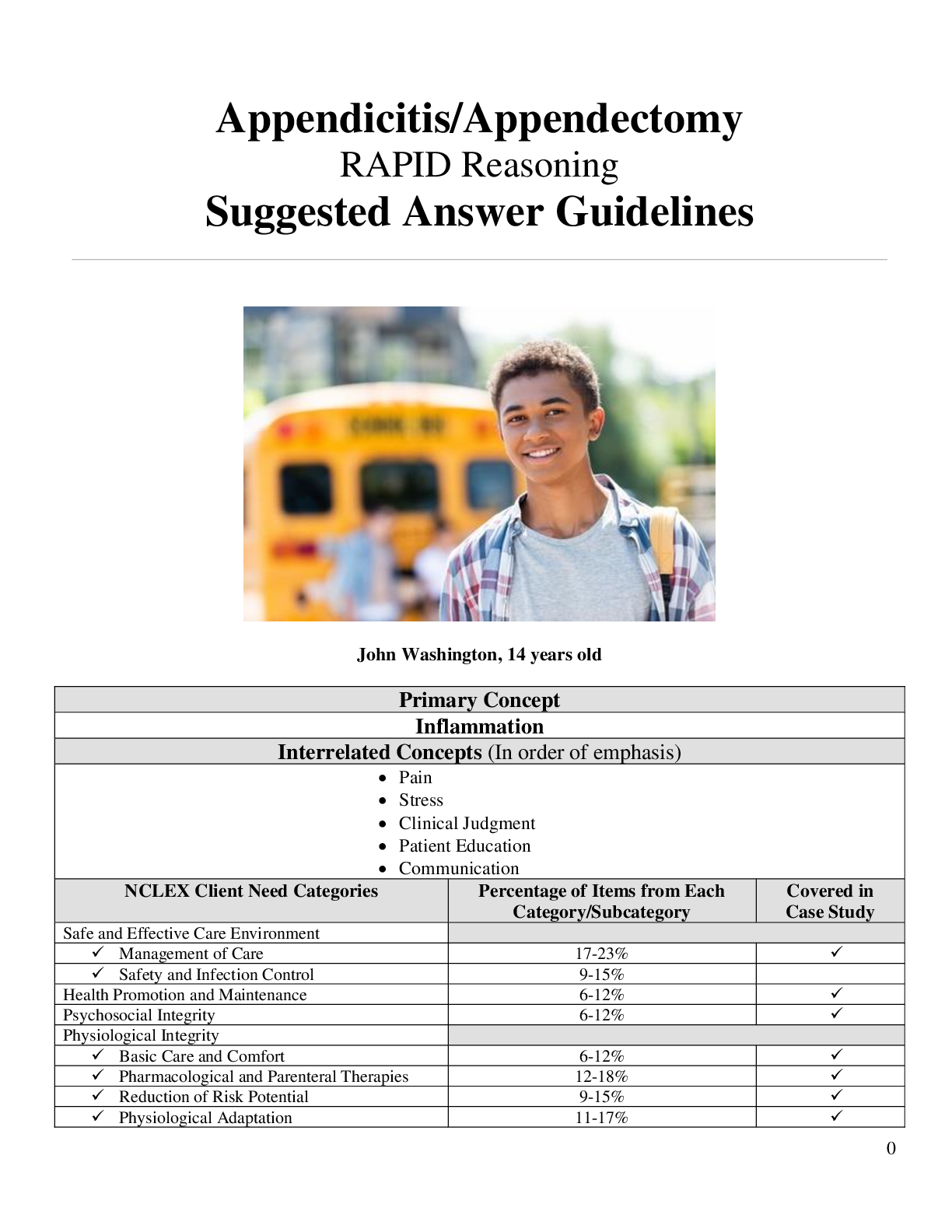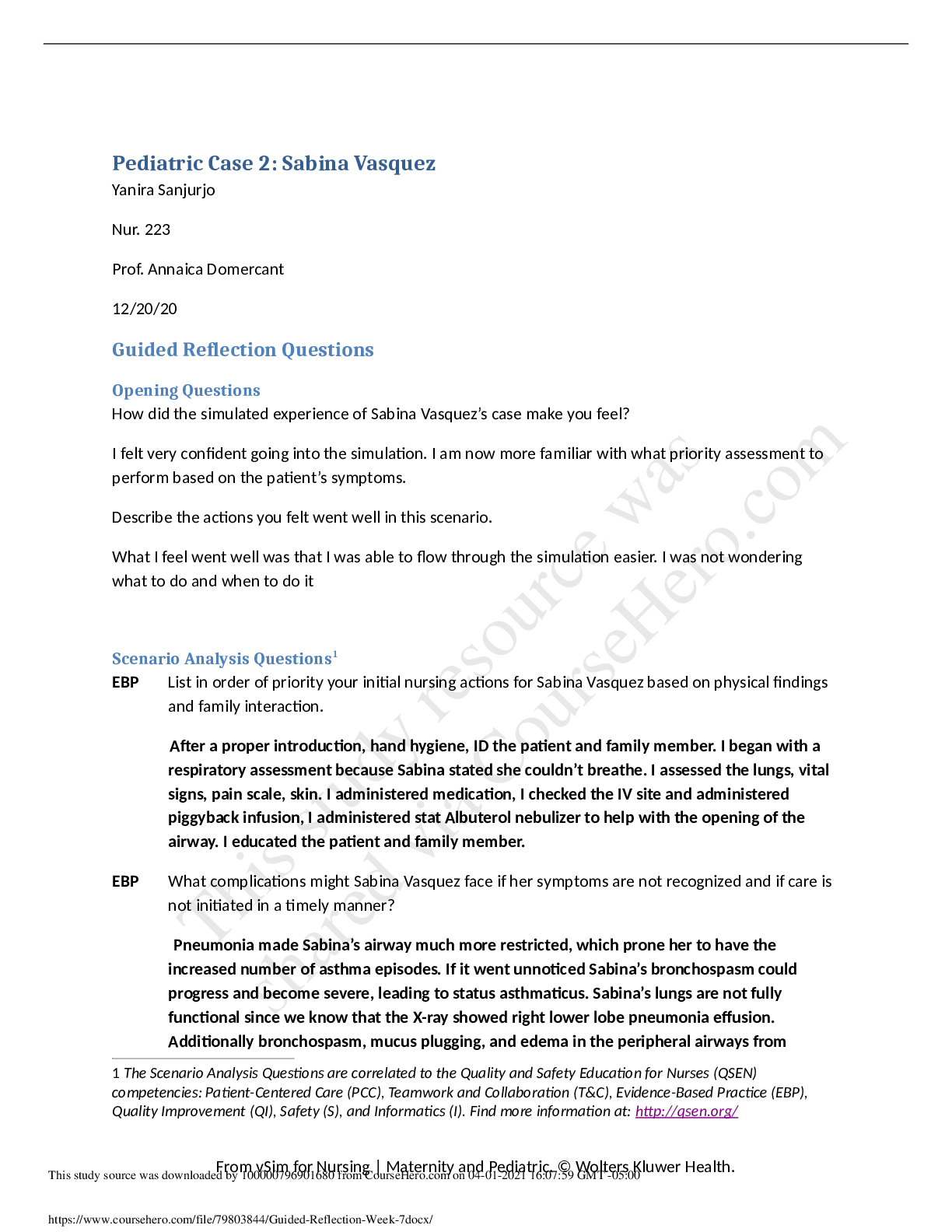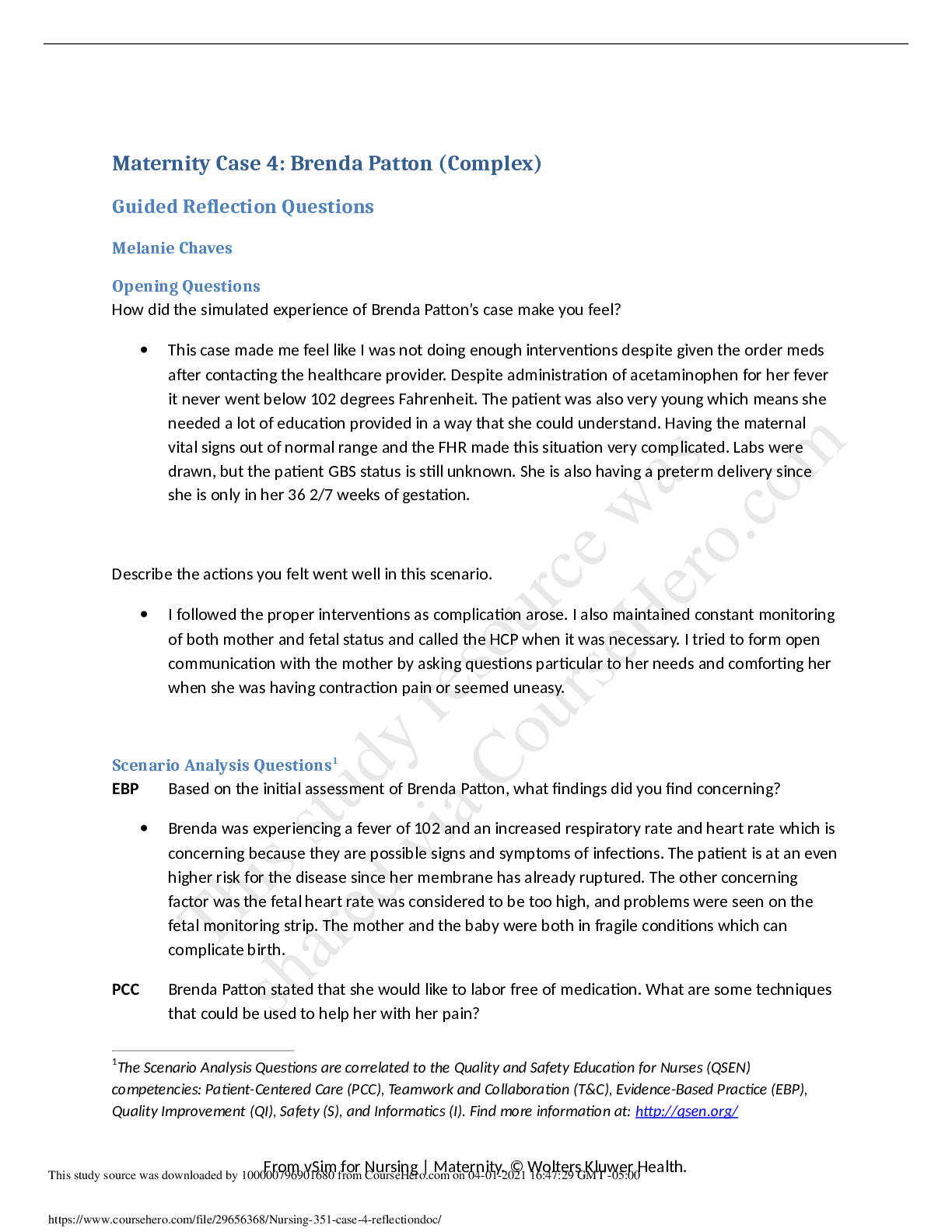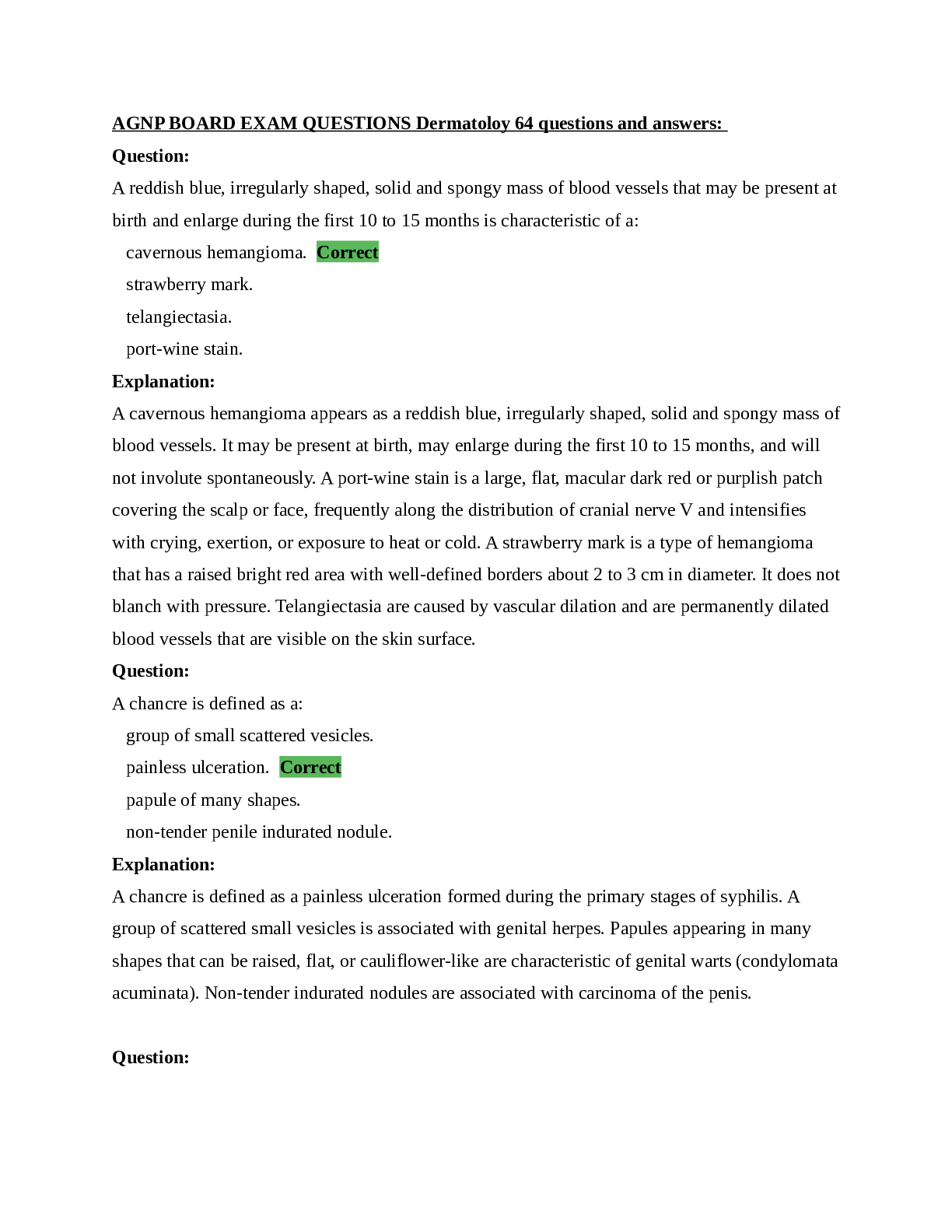*NURSING > EXAM > NSG 6320 AGNP BOARD EXAM QUESTIONS Assessment Eye, Ear, Nose and Throat (166 Questions Graded A 2021 (All)
NSG 6320 AGNP BOARD EXAM QUESTIONS Assessment Eye, Ear, Nose and Throat (166 Questions Graded A 2021)
Document Content and Description Below
NSG 6320 AGNP BOARD EXAM QUESTIONS Assessment Eye, Ear, Nose and Throat (166 Questions Graded A 2021) AGNP BOARD EXAM QUESTIONS Assessment Eye, Ear, Nose and Throat (166 Questions) Question: Ophtha... lmoscopic examination of the fundus reveals small, rounded, slightly irregular red spots embedded in the retina. These findings are consistent with: superficial retinal hemorrhages. preretinal hemorrhages. microaneurysms. deep retinal hemorrhages. Correct Explanation: Deep retinal hemorrhages appear as small, rounded, slightly irregular red spots and are sometimes called dot or blot hemorrhages. They occur in a deeper layer of the retina than flame-shaped hemorrhages. Diabetes is a common cause. Superficial retinal hemorrhages appear as small, linear, flame-shaped, red streaks in the fundi and are seen in hypertension, papilledema, and occlusion of the retinal vein. Preretinal hemorrhages lie anteriorly between the retina and the vitreous and are typically larger than retinal hemorrhages. These hemorrhages obscure any underlying retinal vessel. Microaneurysms present as tiny, round, red spots commonly seen in and around the macular area. These are classic in diabetic retinopathy. Question: The whispered voice test allows the examiner to screen for: low frequency hearing loss. high frequency hearing loss. general hearing loss. Correct conductive hearing loss. Explanation: The whispered voice test for auditory acuity and allows the examiner to screen for general hearing loss. In the elderly who have presbycusis, high frequency hearing loss is present. Since consonants are higher frequency sounds than vowels, these sounds are often missed. Question: On examination of the tympanic membrane, a red bulging ear drum is detected. This is consistent with: acute otitis externa. chronic otitis externa. acute otitis media. Correct a serous effusion. Explanation: A red bulging tympanic membrane may be found in a patient who has acute otitis media. In acute otitis externa, the canal may be swollen, narrow, moist and pale with tenderness on touching. The ear drum is intact. In chronic otitis externa, the skin of the canal may be thickened, red, and pruritic. The ear drum is usually unaffected. With serous effusion the ear drum appears amber and there usually is no bulging of the eardrum. Question: One of the refractive errors of vision that presents with symptoms of blurriness and improved with corrective lens, is known as: hyperopia. myopia. strabismus. astigmatism. Correct Explanation: Myopia, nearsightedness, occurs when light rays focus anterior to the retina. Hyperopia, farsightedness, occurs when light rays focus posterior to the retina. Strabismus, heterotropia, is a condition in which the eyes are not properly aligned with each other. In astigmatism, light rays do not focus correctly on the retina. This causes blurriness. Question: Miosis is a term used to describe: the shape of the pupils. constriction of the pupils. Correct dilation of the pupils. symmetry of the pupils. Explanation: Miosis refers to constriction of the pupils, mydriasis refers to dilation. Miosis is not associated with the shape or symmetry of the pupils. Question: Otosclerosis is an example of a(n): conductive hearing loss. Correct sensorineural hearing loss. mixed hearing loss. acquired hearing loss. Explanation: Otosclerosis is a hereditary disorder of the labyrinthine capsule in which abnormal bone growth occurs around the ossicles resulting in fixation of the stapes. The stapes does not vibrate which reduces sound transmission to the inner ear. This produces a conductive hearing loss. Question: Drooping of the upper eyelid is termed: an epicanthal fold. ptosis. Correct a retracted lid. ectropion. Explanation: Ptosis is a drooping of the upper eyelid and can be caused by myasthenia gravis, damage to the oculomotor nerve, or to the sympathetic nerve supply (Horner's syndrome). A weakened muscle, relaxed tissues, and the weight of herniated fat may cause senile ptosis. Ptosis can also be congenital. An epicanthal fold is a vertical fold of skin that lies over the medial canthus. A retracted lid is seen as a wide eyed stare. Ectropion is seen when the lower lid turns outward and exposes the palpebral conjunctiva. Question: When a light beam shines into one pupil causing pupillary constriction in that eye, the term used is: indirect reaction to light. consensual reaction to light. optic radiation. direct reaction to light. Correct Explanation: The pupils of both eyes respond identically to a light stimulus regardless of which eye has been stimulated. The direct response describes light entering one eye that produces constriction of the pupil of that eye. A consensual response describes constriction of the unstimulated pupil. These reactions should be compared in both eyes and if there is a difference, further investigation is warranted. Optic radiation is a term used to describe the tract that nerve impulses follow through the retina, optic nerve, and optic tract. Question: Where in the mouth would reddened areas, nodules, or ulcerations that are suspicious of malignancy be present? Mucous membranes Tongue Correct Gums Palate Explanation: Reddened areas, nodules, or ulcerations noted on the sides and undersurface of the tongue and the floor of the mouth would be suggestive of cancer. Cancer of the tongue is the second most common cancer of the mouth; the lip is number one. Question: An example of a cause of conductive hearing loss in children would be: prolonged use of tobramycin. the presence of a peanut in the ear for three weeks. Correct congenital rubella syndrome. maternal history of Herpes infection. Explanation: Conductive hearing loss is the most common type in children. It occurs when the transmission of sound through the external or middle ear is blocked. It may be temporary or permanent, unilateral or bilateral. It may also be caused by physical abnormalities present from birth, but more commonly, it begins during childhood as the result of middle ear infections, perforation of the eardrum, impacted earwax or objects present in the ear canal. The other choices are examples of sensorineural hearing losses. Question: A man with a history of long-term use of chewing tobacco presents with a mouth lesion that is suspicious for malignancy. Oral assessment findings describe: a smooth circular pustule lesion on the base of the gum. a soft, solitary papule lesion located apical to the molar. a small, shallow, sore lesion at the base of the gums. an ulcerated lesion with indurated margins on the lateral tongue. Correct Explanation: Oral malignant lesions present as ulcerated with indurated margins and are not usually circular or smooth. A dental abscess presents as a soft, solitary papule located apical to the molar. Canker sore is a small, shallow sore at the base of the gum. Question: Mydriasis is a term used to describe: the shape of the pupils. constriction of the pupils. dilation of the pupils. Correct symmetry of the pupils. Explanation: Miosis refers to constriction of the pupils, mydriasis refers to dilation. Miosis is not associated with the shape or symmetry of the pupils. Question: Ophthalmoscopic examination of the retina reveals AV tapering. This appears as if the: vein "winds" down on either side of the artery. Correct vein is twisted on the distal side of the artery. vein crosses beneath the artery. vein stops abruptly on either side of the artery. Explanation: When the arterial walls lose their transparency, changes appear in the arteriovenous crossings. Decreased transparency of the retina probably contributes to AV nicking and AV tapering. In tapering, the vein appears to taper or "wind" down either side of the artery. In AV nicking, the vein appears to stop abruptly on either side of the artery. In the normal eye, the vein appears to cross beneath the artery. With banking, the vein appears to be twisted on the distal side of the artery and forms a dark wide knuckle appearance. Question: Causes of sensorineural hearing loss include all of the following except: aging. loud noises over prolonged periods of time. perforated tympanic membrane. Correct acoustic neuroma. Explanation: A perforated tympanic membrane is an example of a cause of a conductive hearing loss. Sensorineural hearing loss involves disorders of the cochlear nerve, cochlea, and an interruption in the neuronal impulse transmission to the brain. Causes include: exposure to loud noises, inner ear infections, acoustic neuroma, aging, and congenital and/or familial disorders. Question: All of the following diseases may be associated with the appearance of a strawberry tongue except: scarlet fever. folic acid and B-12 deficiencies. rubeola. Correct Kawasaki syndrome. Explanation: There are five medical reasons for the appearance of strawberry tongue: Kawasaki disease, scarlet fever, folic acid and vitamin B-12 deficiencies, bacterial toxic shock syndrome, and a geographic tongue. Rubeola does not present with a strawberry tongue. Koplik's spots are diagnostic of rubeola and they appear as clustered white lesions on the buccal mucosa. Question: Janeway lesions of the palms and soles appear as: painful, red, raised lesions. small, nontender, erythematous nodules. Correct hemorrhagic vesiculopustular eruptions. hemorrhagic petechiae. Explanation: Janeway lesions present as small, nontender, erythematous macular or nodular lesions on the palms or soles. Osler nodules are painful, red, raised lesions on the hands and feet. Both Janeway lesions and Osler nodules are indicative of infective endocarditis. Hemorrhagic vesiculopustular eruptions can be associated with gonococcemia. Hemorrhagic petechiae are suggestive of meningococcemia. Question: Which of the following screening tests for hearing loss can detect both sensorineural and conductive hearing loss? Weber Test Correct Rinne Test Whispered Voice Test bilateral hearing loss. Explanation: The Weber hearing screening test can detect unilateral conductive hearing loss (middle ear hearing loss) and unilateral sensorineural hearing loss (inner ear hearing loss). Question: Examination of the nose and paranasal sinuses reveal local tenderness, pain, fever, and rhinorrhea. These symptoms are suggestive of: chronic sinusitis of the frontal and maxillary sinuses. allergic rhinitis. upper respiratory infection. acute sinusitis of the frontal and maxillary sinuses. Correct Explanation: With examination of the nose and paranasal sinuses, the presence of local tenderness, together with symptoms such as pain, fever, and nasal discharge, suggest acute sinusitis involving the frontal or maxillary sinuses. Chronic sinusitis usually lasts longer than 3 months and presents with some of the same symptoms as acute sinusitis. This may include thick yellow or green rhinorrhea, facial pain, headaches, and dizziness. Question: The mouth of a ten-month-old infant has white patches on the mucosa that cannot be removed. These patches are consistent with: stomatitis. thrush. Correct Koplik spots. measles. Explanation: Oral thrush is a condition in which the fungus, Candida albicans, accumulates on the lining of the mouth. Oral Candida infections like thrush, are also common side effects of antibiotic therapy due to alterations of the normal bacterial flora. Thrush appears as white patches on the mucosa and does not wipe off. White patches do not appear with stomatitis or measles. Koplik spots are small, white spots with a bluish center on a reddened background that occur on the inside of the cheeks early in the course of measles. Question: In patients who have allergic rhinitis, the nasal mucosa appears: erythematous. pale. Correct green. yellow. Explanation: Rhinitis is inflammation of the nasal mucosa. Normally, the nasal mucosa appears somewhat redder than the oral mucosa. With allergic rhinitis, it appears pale, bluish, or a darker red than normal. In viral rhinitis, it tends to appear erythematous and swollen. A yellow or green color may be due to the appearance of exudate in the nasal cavity. Question: Assessment of a 4 year-olds visual acuity resulted in 20/30 in the left eye and 20/40 in the right eye using the Snellen eye chart. This means: his vision is normal for his age. Correct his vision is abnormal and further testing is warranted. the patient may not be able to read so he should be tested with the picture or "E" eye charts. he has astigmatism. Explanation: Expected visual acuity in a 4 year old is 20/40. At age 5 years, it is expected to be 20/30. By age 6 years, vision should be 20/20 bilaterally. Question: Round or oval shaped lesions surrounded by erythematous mucosa and noted on an area of the oral mucosa may be: leukoplakia. aphthous ulcers. Correct Koplik's spots. ulcerative gingivitis. Explanation: Aphthous ulcers can appear anywhere on the buccal mucosa or tongue. They usually appear as round or oval ulcers, can be white or yellowish gray in color, and are surrounded by a halo of reddened mucosa. They are usually painful. Leukoplakia presents as thickened white patches anywhere on the oral mucosa. Koplik's spots appear in the early stages of measles (rubeola). They appear as small white specks that resemble grains of salt on a red background on the buccal mucosa. They are not usually painful. Ulcerative gingivitis is a painful form of gingivitis that is characterized by the development of ulcers in the interdental papillae. If untreated they can become necrotizing along the gum margins and appear as erythematous ulcers. [Show More]
Last updated: 1 year ago
Preview 1 out of 69 pages
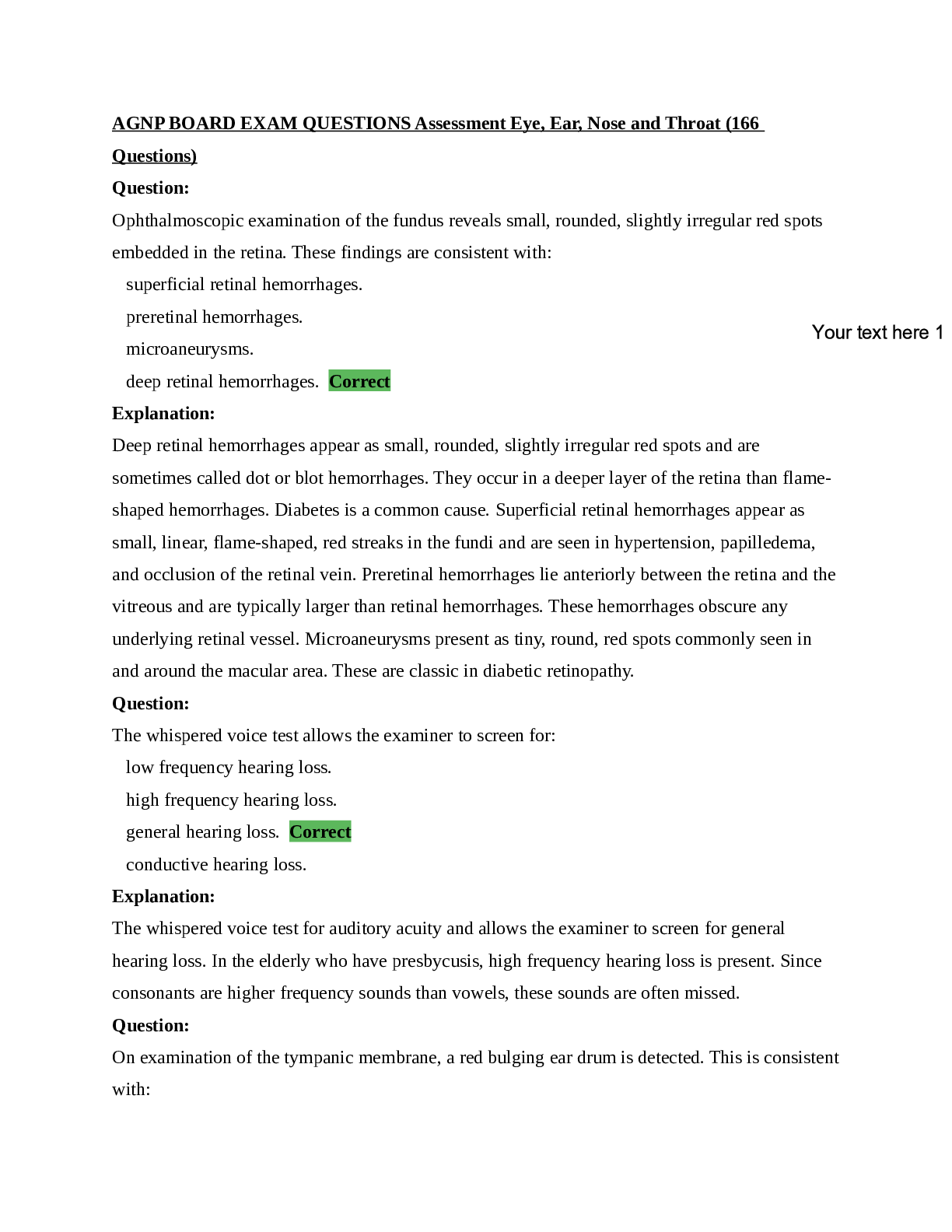
Reviews( 0 )
Document information
Connected school, study & course
About the document
Uploaded On
Feb 27, 2021
Number of pages
69
Written in
Additional information
This document has been written for:
Uploaded
Feb 27, 2021
Downloads
0
Views
68


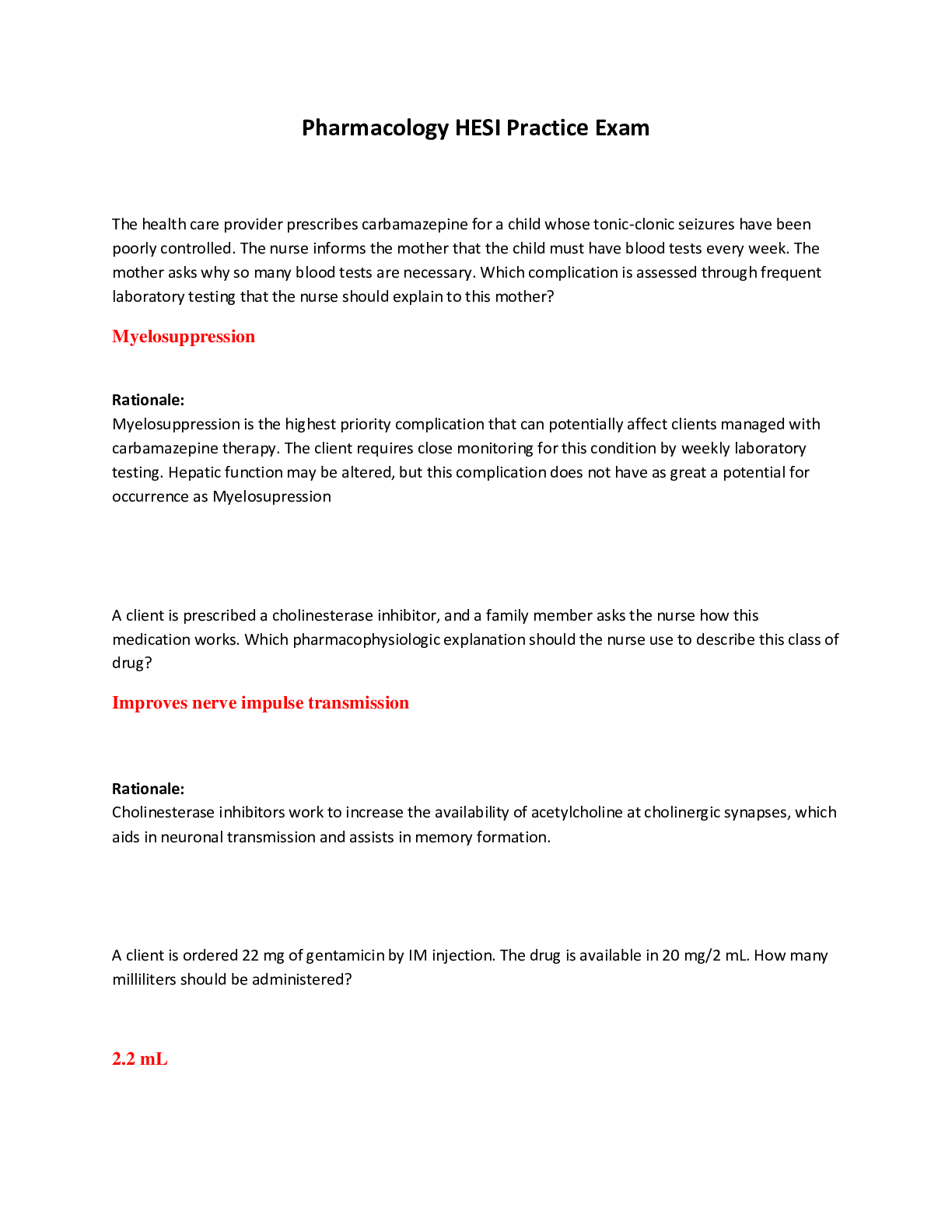
.png)
